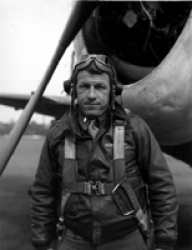
 |
|
|
||
|
Paul Albert Conger |
||||
|
Engagements: • World War II (1941 - 1945)• Korean War (1950 - 1953) |
||||
| Biography: | ||||
|
Paul Albert Conger Paul Albert Conger enlisted in the Aviation Cadet Program of the U.S. Army Air Corps on 7 November 1941. Upon completion of flight training, on 3 July 1942 he was commissioned as a Second Lieutenant in the U.S. Army Air Corps with the rating of Pilot. His next assignment was to transition training to the P-47 Thunderbolt with the 61st Fighter Squadron, 56th Fighter Group. In January 1943, his unit was deployed to RAF Kings Cliffe near Kings Cliffe, Northamptonshire, 12 miles west of Peterborough in Cambridgeshire, England, and became part of the Eighth Air Force. Kings Cliffe was assigned U.S. Army Air Forces designation Station 367. On 11 December 1943, then-Captain Paul Albert Conger was serving with the 61st Fighter Squadron, 56th Fighter Group, Eighth Air Force in the European Theater of Operations. On that day, CPT Conger's unit was in aerial combat against German forces. CPT Conger was piloting a P-47 Thunderbolt fighter and leading a flight of P-47 fighters on a bomber escort mission against a military installation in a heavily defended area near Emden, Germany. Seeing a large number of rocket-carrying enemy planes escorted by fighters and forming for attack against the bombers, CPT Conger led his flight in an attack against the enemy formation. During the attack, he destroyed one enemy plane and damaged another. In doing this, CPT Conger and his wingmen dispersed a vastly-superior force and prevented harm to the bombers. As he regained altitude, CPT Conger saw an ME-110 fighter, flying with a JU-88 fighter, and attacked them, following the JU-88 to an extremely low altitude and destroying it. He then turned into an attack on the ME-110 fighter and forced it to crash into the sea. CPT Conger's superb flying skill, courageous actions and extraordinary heroism that day earned him the U.S. Army's second highest award for valor, the Distinguished Service Cross. Conger was transferred to the 63rd Fighter Squadron, 56th Fighter Group at Station 365, Halesworth, Suffolk, England in December 1944. Now-Major Conger became Commander of the 63rd Fighter Squadron on 20 January 1945 and served in that position until 19 March. During World War II, Conger was credited with a total of 11.5 enemy aircraft destroyed in aerial combat, and damaging 4 more. Major Conger assisted in reactivation of the 56th Fighter Group at Selfridge Field, MI, in May 1946, and then left active duty with the USAAF. On 17 November 1946, Conger joined the newly-created U.S. Air Force Reserve and served with Continental Air Command in Los Angeles, CA. Lt Col Conger retired on 5 February 1958. Medals, Awards and Badges Distinguished Service Cross Distinguished Service Cross Citation The President of the United States of America, authorized by Act of Congress July 9, 1918, takes pleasure in presenting the Distinguished Service Cross to Captain (Air Corps) Paul Albert Conger (ASN: 0-661193), United States Army Air Forces, for extraordinary heroism in connection with military operations against an armed enemy while serving as Pilot of a P-47 Fighter Airplane in the 61st Fighter Squadron, 56th Fighter Group, EIGHTH Air Force, in aerial combat against enemy forces on 11 December 1943. On this date Captain Conger led a flight of P-47 fighters on a bomber escort mission against a military installation in a heavily defended area near Emden, Germany. Observing a large number of rocket-carrying enemy planes, escorted by fighters forming for attack against the bombers, Captain Conger, with complete disregard for the danger involved led his flight in a vicious attack against the enemy formation during which he destroyed one enemy plane and damaged another. In this encounter Captain Conger and his wingmen by aggressive, skillful flying, and accurate gun fire dispersed a vastly superior force and prevented harm to the bombers. After regaining altitude, Captain Conger saw an ME 110 fighter flying with a JU 88 fighter and immediately attacked them, following the JU 88 to an extremely low altitude and destroying it. He then turned into the ME 110 fighter and attacked with such a fury that he forced the enemy to crash into the sea. By his extraordinary flying skill, gallant leadership, and great courage, Captain Conger rendered outstanding distinguished and valorous service to our nation. General Orders: Headquarters, U.S. Strategic Forces in Europe, General Orders No. 26 (1944) Congressional Gold Medal The Congressional Gold Medal, created by the U.S. Mint, is the highest civilian honor Congress can give on behalf of the American people. On 20 May 2015, leaders from the U.S. House of Representatives and Senate presented the Congressional Gold Medal to the American Fighter Aces Association at the U.S. Capitol Visitor Center Emancipation Hall. More than 60,000 American fighter pilots engaged in aerial combat during World War I, World War II, the Korean War and the Vietnam War. Of those pilots, only 1,447 earned the title of fighter “Ace” by downing at least five enemy aircraft. Lieutenant Colonel Paul Albert Conger was one of them, having been credited with 11.5 aircraft shot down in aerial combat and damaging 4 more, qualifying as a "Double Ace." At the time of the presentation of the Medal, only 75 of those Aces remained alive. Death Lieutenant Colonel Paul Albert Conger died on 20 August 1994. The location of his remains is unknown. https://www.findagrave.com/cgi-bin/fg.cgi?page=gr&GRid=156795711 |
||||
| Honoree ID: 312481 | Created by: MHOH | |||
Ribbons
Medals
Badges
Honoree Photos
 |  |  |
 |  |
 |


